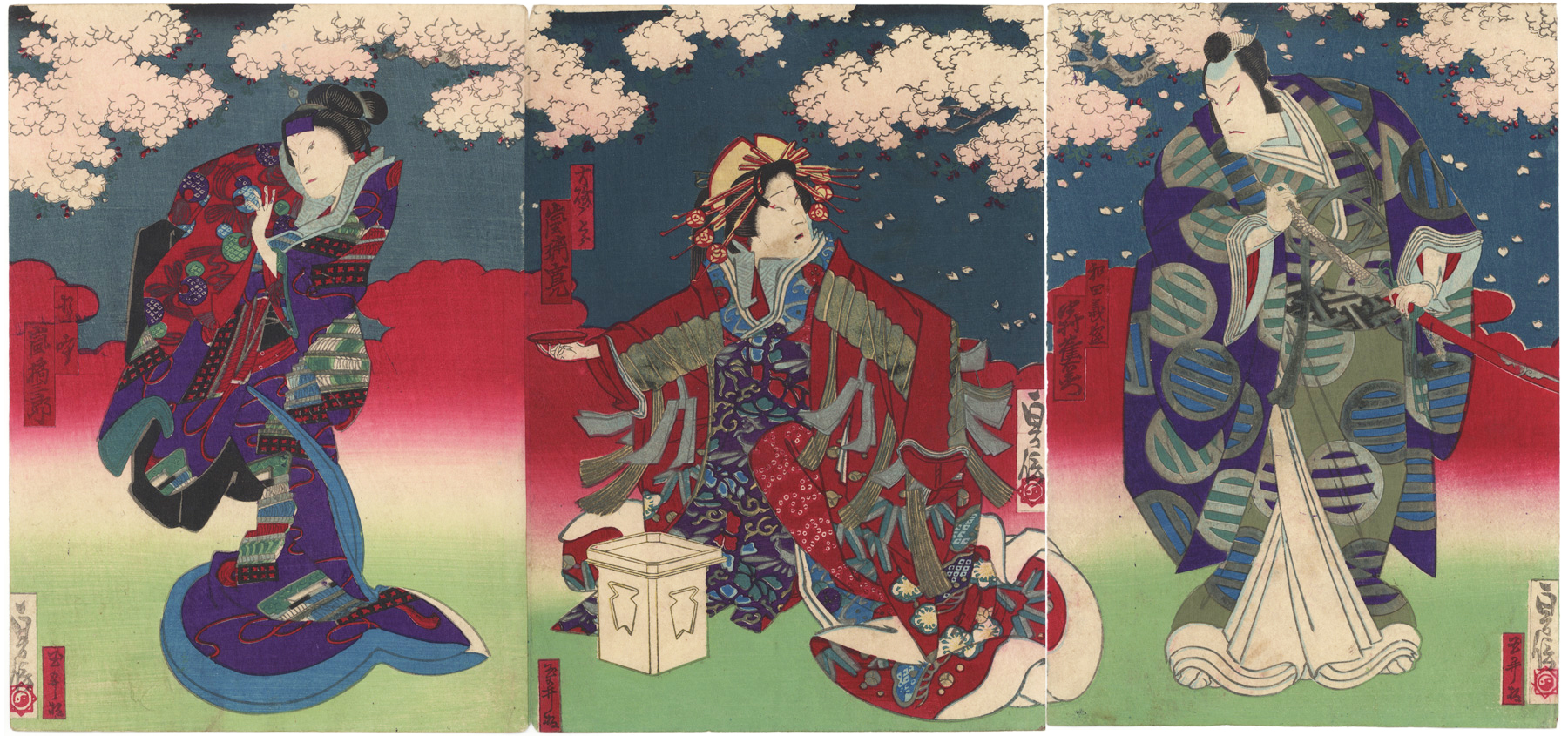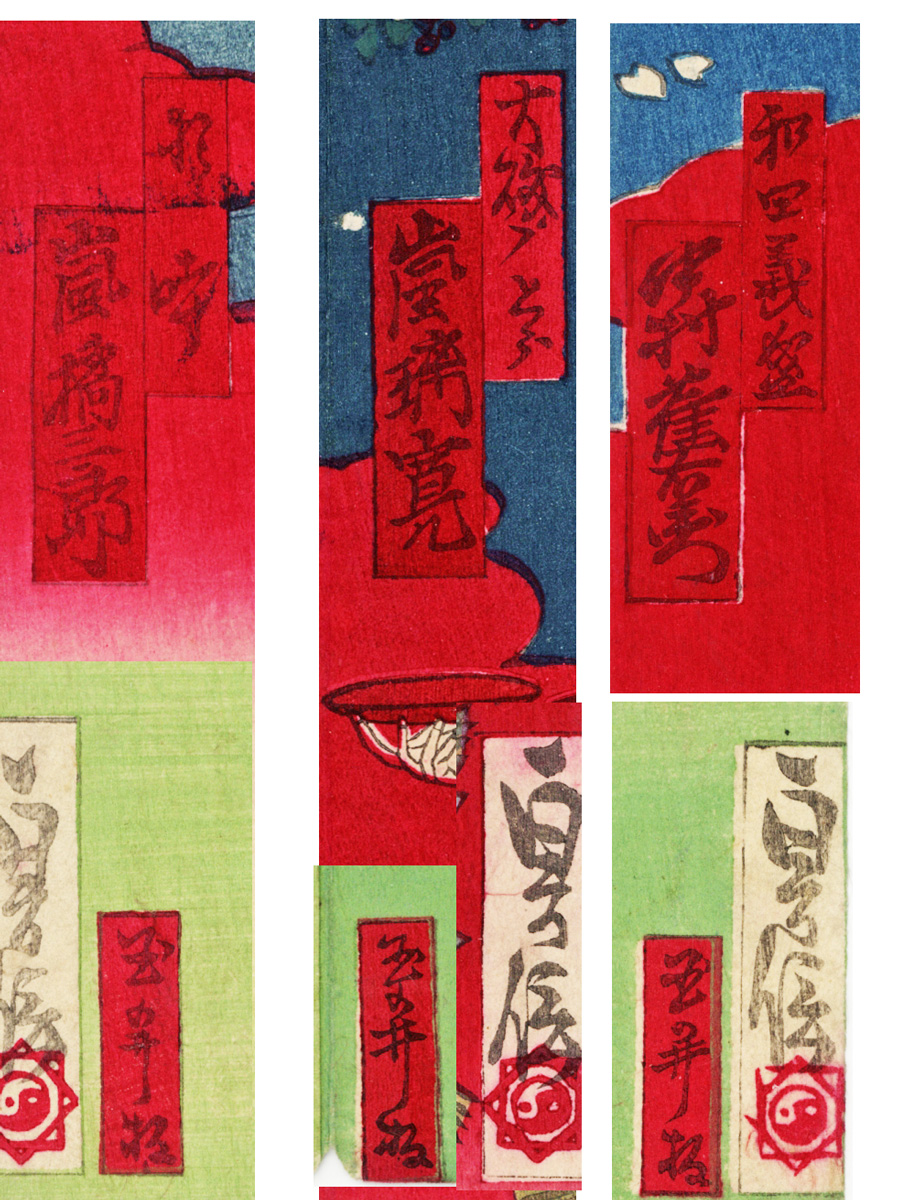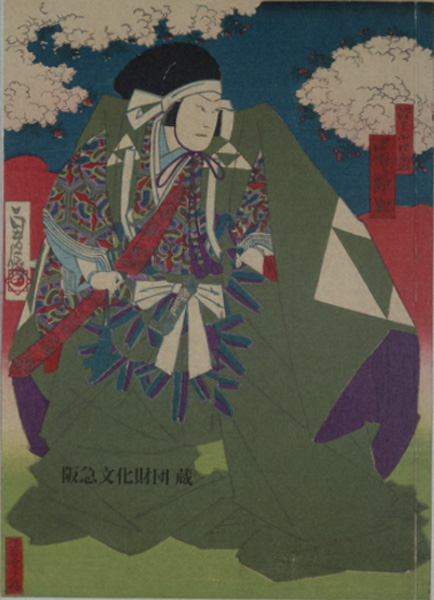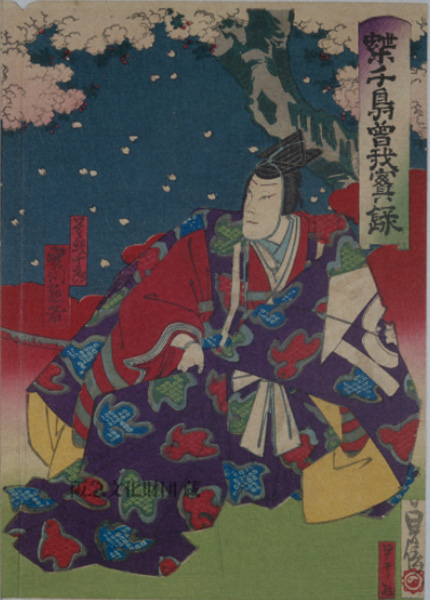About This Print
Source: with thanks to John Fiorillo and Peter Ujlaki for identifying the play, confirming the actors and their roles and filling in the blanks in my information about this print.
The three middle panels of a pentatych (missing two panels shown below) depicting the actors Nakamura Jakuemon II, Arashi Rikan IV and Arashi Kitsusaburô IV in the play Chō chidori Soga no jitsuroku (A True Tale of Butterflies and Plovers), a tale based on the revenge of the Soga brothers - a Sogmono 曽我物.
As noted by John Fiorillo, "The title incorporates the crests or symbols associated with the two avenging brothers - Soga no Gorō (曾我の五郎) = Chō (蝶), butterflies and Soga no Jūrō (曾我の十郎" = Chidori (千鳥), a species of plover]."
Depicted from right to left in this collection's three panels are Nakamura Jakuemon II (二代目 中村雀右衛門, 1841-1895) as Wada Yoshimori (和田義盛); Arashi Rikan IV ( 四代目 嵐璃寛, 1837-1894) as Ōiso no Tora (大磯ノとら) [Ōiso no Tora Gozen 大磯虎御前] and Arashi Kitsusaburô IV (四代目 嵐橘三郎, 1841-1915) as Ōji (お時).
The play was staged at the Ebisu-za 戎座, one of five kabuki theaters at the time in the Dotonbori neighborhood in Ōsaka, in March 1879.1
cartouche detail - right, center and left panels
click on image to enlarge
The Left and Right Panels of the Pentatych
click on images to enlarge
1 National Diet Library The Meiji and Taisho Eras in Photographs https://www.ndl.go.jp/scenery/e/column/kansai/dotonbori_neighborhood.html
Sogamono
Source: website of Kabuki21
Dramas or dances based on the famous revenge of the Soga brothers. The 28th of the 5th lunar month of 1193 (the 28th of June 1193 in the western calendar), the brothers Soga Gorō Tokimune and Soga Jūrō Sukenari killed Kudō Saemon Suketsune, who assassinated their father in 1175. This revenge occurred during a hunting party organized at the foot of Mt. Fuji by Kudō, with Minamoto Yoritomo as the guest of honour. The Soga brothers became Kabuki heroes during the 18th century and countless of dramas were produced with their sekai.1 It was a custom for all the Edo theaters to produce a sogamono as new year program. The Soga brothers' sekai was used from January up to the end of May. The two characters are highly stylized: Gorō is impetuous, wears costumes decorated with butterflies and is usually played in the aragoto style.2 Jūrō is refined, wears costumes decorated with plovers (chidori) and is usually played in the wagoto style.3
1 In Kabuki, a sekai is a dramatic world, with a well-defined set of characters and actions, related to well-known historical events or legends.
2 A Kabuki bombastic style exagerating all the aspects of the role
3 The "gentle style". One important Kabuki acting style, usually opposed to the aragoto style.
Osaka Region Prints - Kamigata-e (Osaka-e)
While Edo/Tokyo was the dominant center of woodblock print production, Osaka was an important regional production center focusing on the Osaka theater. Osaka actor prints (kamigata-e) took on a different, smaller (chūban-size) and less spectacular, appearance than those produced in Edo/Tokyo. While Edo audiences demanded their fire and brimstone, Osaka kabuki patrons craved intricate, heartrending plots.
Kawasaki Kyosen (1841-1899) the son of Yoshitaki and a print designer himself, provides a glimpse into the start of the design process in his account of the Osaka print making process, as follows:
In those days, certain Osaka publishers set out to the theaters on opening day with the artists who drew actors’ likenesses. The dividers were removed from four or five boxes right in the middle of the floor section of the theater and spread with rugs. Tables were set up with brushes and paper, and all was made ready to sketch the happenings on stage. The artist sat in the middle, with the proprietor of the publishing house and his clerks alongside. Besides them, some first-class female entertainers managed the food and drink, so things were quite lively. This was a form of promotion, as much as to say that actor prints were being designed for this performance.1 – an account by the artist’s son, Kawasaki Kyosen (1841-1899)
1 The Theatrical World of Osaka Prints, Roger S. Keyes and Keiko Mizushima, David R. Godine in association with Philadelphia Museum of Art, 1973 p. 318. For a complete transcript see the article "Production of Actor Prints in Osaka" on this site at https://sites.google.com/a/myjapanesehanga.com/www/home/articles/production-of-actor-prints-in-osaka
Print Details
| IHL Catalog | #802 |
| Title or Description | Nakamura Jyakuemon as Wada Yoshimori, Arashi Rikan as Ōiso no Tora and Arashi Kitsusaburō as Ōji in Chō chidori Soga no jitsuroku 中村雀右衛門 和田義盛, 嵐璃寛 大磯ノとら, 嵐橘三郎 お時 蝶千鳥曽我実録 (ちょうちどりそがのじつろく) Note: also seen translated as Butterflies and Plovers series: The True Story of the Soga Brothers |
| Series | |
| Artist | Hasegawa Sadanobu II (1848-1940) |
| Signature |  貞信 Sadanobu 貞信 Sadanobu |
| Seal | stylized seal (kaō) incorporating yin/yang symbol as shown above |
| Publication Date | March 1897 明治12(1879)03月吉日 |
| Publisher | 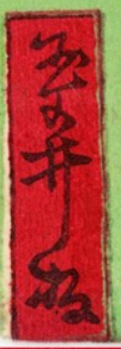 Tamanoi 未詳 (玉ノ井) 玉ノ井板publisher's seal reading Tamanoi han present on all three panels [Marks: pub. ref. U323; seal not shown] |
| Carver | unknown |
| Printer | unknown |
| Impression | excellent |
| Colors | excellent |
| Condition | good - three panels joined |
| Genre | ukiyo-e; yakusha-e |
| Miscellaneous | |
| Format | chūban vertical triptych |
| H x W Paper | 9 1/2 x 23 7/16 in. (24.1 x 59.5 cm) (entire triptych) |
| H x W Image | 9 1/2 x 23 7/16 in. (24.1 x 59.5 cm) (entire triptych) |
| Literature | |
| Collections This Print | Japan Arts Council 図録No. 17122 (two right-most panels of pentatych); Hankyu Culture Association No. 中S241-01, 02, 03, 04, 05 (all five panels) |
6/6/2021 created


